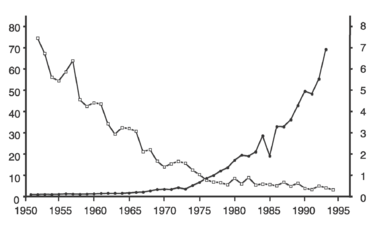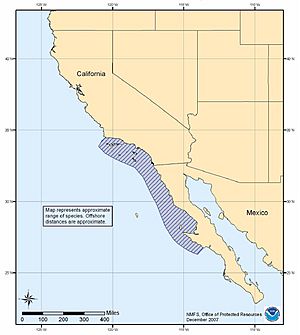Haliotis sorenseni facts for kids
Quick facts for kids Haliotis sorenseni |
|
|---|---|
 |
|
| A live individual of Haliotis sorenseni, left of center. The shell and the rock are covered with red coralline algae. | |
| Conservation status | |
| Scientific classification |
The white abalone, known scientifically as Haliotis sorenseni, is a type of large sea snail. It is a marine gastropod (a kind of snail) and a mollusk. It belongs to the family called Haliotidae, which includes all abalones.
The white abalone is an endangered species in the United States. It might have the smallest population among all eight abalone species found on the west coast of North America.
Contents
Where White Abalones Live (Distribution)
Historically, white abalones lived from Point Conception, California, all the way down to Baja California, Mexico. They were especially common around islands off the coast.
In the northern part of California, white abalones were often found along the mainland coast. However, in the middle part of California, they were more common near offshore islands. These included San Clemente and Santa Catalina Islands. Further south, in Baja California, Mexico, they were found more along the mainland. They also lived near islands like Isla Cedros and Isla Natividad.
Scientists are not sure why this pattern existed. It might be because there wasn't enough good habitat along the mainland in the middle of their range. Or, it could be due to too much fishing in those easier-to-reach mainland areas.
Since the mid-1990s, only a few white abalones have been found. These isolated survivors are along the mainland coast in Santa Barbara County. They are also at some offshore islands and banks. This suggests their current range in California is similar to what it used to be.
There is no recent information about their current range in Baja California. The white abalone population in Mexico is thought to be very low. This is based on old fishing data. However, we don't know much about their exact status there today.
What White Abalones Look Like (Description)
Their Shell
The white abalone's shell usually has between 3 to 5 open holes. These holes are called respiratory pores. They form a line as the shell grows. The shell is oval-shaped, very thin, and deep. White abalones can grow up to 10 in (25 cm) long. However, they are usually between 5–8 in (13–20 cm).
Their Body (Anatomy)
The white abalone has special sensory parts called epipodial tentacles. These look lacy and are beige and yellow-green. The bottom of its foot is orange. The epipodium, which is an extension of the foot with tentacles, is a mix of orange and tan colors.
How White Abalones Live (Ecology)
Their Home (Habitat)
The white abalone lives deeper than any of the other eight California abalone species. They live at depths from 80 to 200 ft (24–61 m).
White abalones are found in rocky areas with open spaces. These areas have low or high rock formations mixed with sand channels. Sand channels might be important for moving and collecting macroalgae (large seaweeds). White abalones are known to eat various red algae found in these areas.
What They Eat (Feeding Habits)
The white abalone is a herbivore, meaning it eats plants. It mainly grazes on macroalgae. Some of these include Laminaria farlowii and Agarum fimbriatum. They also eat several types of red algae. Other species they eat are Chondracanthus exasperatus, Macrocystis pyrifera, and Palmaria mollis.
Their Life Cycle (Reproduction)
Like many gastropods, white abalones have a complex life cycle. This includes different larval stages. Fertilized eggs hatch into tiny larvae. These larvae then change into the adult form. They settle from the plankton onto a hard surface.
White abalones reproduce by releasing their eggs and sperm into the water. This is called broadcast spawning. If an egg is fertilized, it hatches in just one day. However, a lot of sperm is needed for an egg to be fertilized. So, groups of adult male and female abalones must be close together for successful reproduction.

How Humans Have Used White Abalones (Human Use)
In the early 1970s, biologists from Scripps Institution of Oceanography studied white abalone habitats. They found many white abalones, about one per square yard. This was similar to how many shallower abalone species were found in areas that had not been fished. Sadly, the high demand for white abalones led to a "boom-and-bust" fishing period. This caused the population to drop very quickly in just seven years.
White abalones were considered a special food in California. They are the rarest of the six abalone species in the state. Their population has dropped by more than 99.99%. This was mainly due to too much fishing. The fishery was closed in 1996. At the same time, prices for white abalones went up a lot. In 2001, white abalones became the first marine invertebrate (animal without a backbone) on the United States Federal List of Endangered Species.
Scientists are working hard to save this species. White abalones are now being raised in special farms. This process is called mariculture. The goal is to produce young abalones that can be put back into the ocean. This effort hopes to bring the species back to healthy population levels before it disappears forever.
- Sources
- This article includes information from public domain texts (works from the United States Government). It also uses text shared under a CC-BY-2.5 license.
- National Marine Fisheries Service. (October 2008). "White Abalone Recovery Plan (Haliotis sorenseni)". National Marine Fisheries Service, Long Beach, CA. PDF




